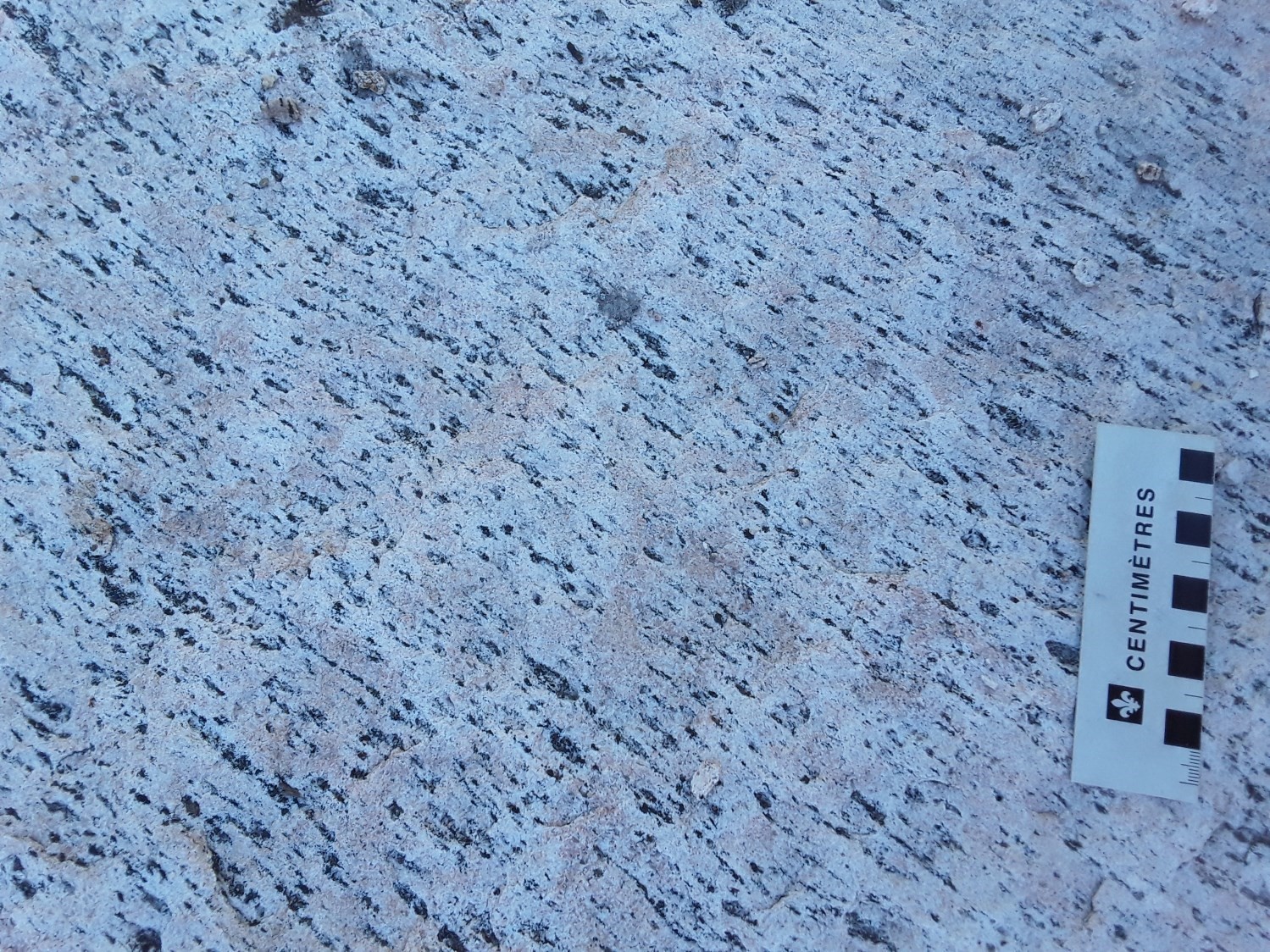
DISCLAIMER: This English version is translated from the original French. In case of any discrepancy, the French version shall prevail.
| Author(s): | El Bourki and Moukhsil, 2021 |
| Age: | Mesoproterozoic |
| Stratotype: | Reference outcrop 2021-FS-4151 |
| Type area: | East of Festins Lake (NTS sheet 32H07) |
| Geological province: | Grenville Province |
| Geological subdivision: | Allochton |
| Lithology: | Mafic, intermediate and felsic plutonic rocks |
| Category: | Lithodemic |
| Rank: | Suite |
| Status: | Formal |
| Use: | Active |
None
Background
The Festins Plutonic Suite was defined by El Bourki and Moukhsil (2021) during mapping work in the areas north of Dolbeau-Mistassini (sheet 32H01), Girardville and Blondelas Lake (sheet 32H07), in the Saguenay–Lac-Saint-Jean region.
The name refers to Festins Lake (sheet 32H07).
Description
The Festins Plutonic Suite is a polyphase batholith composed of alkali feldspar granite, mangerite, gabbronorite, quartz syenite, syenite, hypersthene syenite, quartz monzodiorite and charnockite, with enclaves of paragneiss and migmatite.
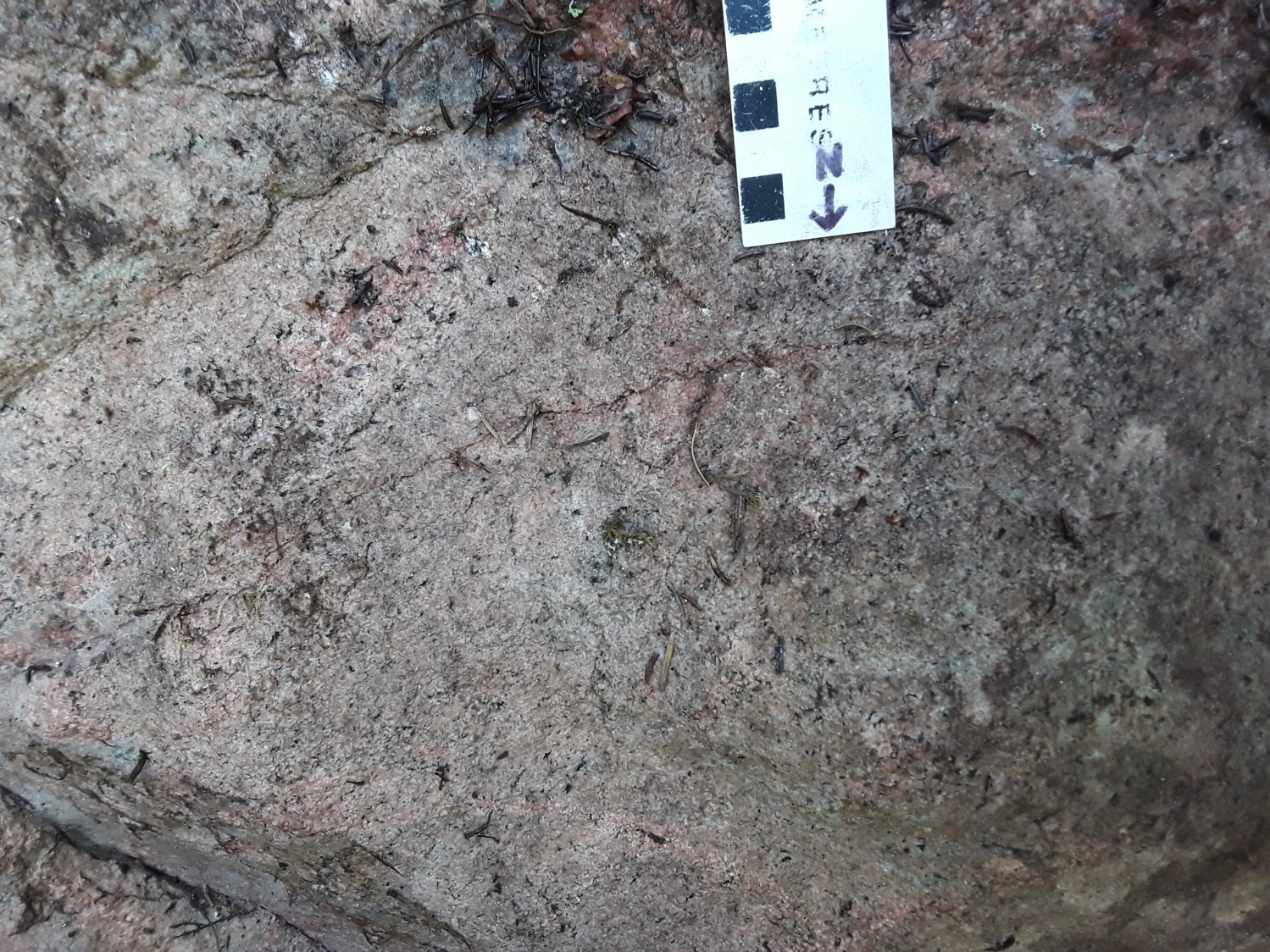
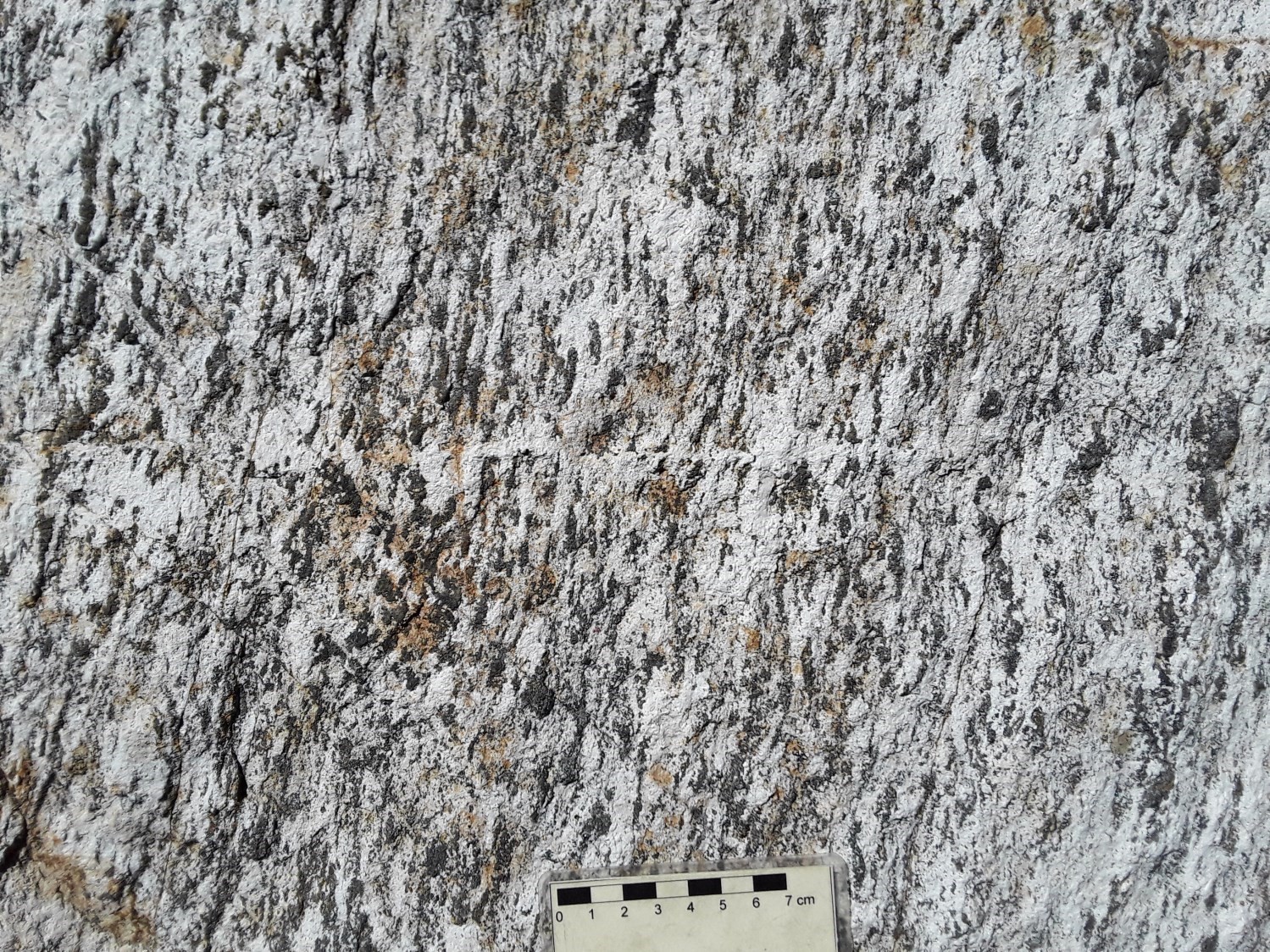 Alkali feldspar granite is generally pink to pink-grey in alteration patina and pink-grey on the fresh surface, with a fine to medium granulometry and granoblastic, it shows foliation deformation in the solid state (e.g., outcrops 2021-GS-2327 and 2021-FT-3049). It consists of quartz, perthitic and non-perthitic potassium feldspar, plagioclase, biotite, magnetite, traces of pyroxenes (orthopyroxene and clinopyroxene) and accessory minerals consisting of epidote and zircon. Alkali feldspar granite is also observed in the form of millimetric to centimetric injections in the other facies of this suite.
Alkali feldspar granite is generally pink to pink-grey in alteration patina and pink-grey on the fresh surface, with a fine to medium granulometry and granoblastic, it shows foliation deformation in the solid state (e.g., outcrops 2021-GS-2327 and 2021-FT-3049). It consists of quartz, perthitic and non-perthitic potassium feldspar, plagioclase, biotite, magnetite, traces of pyroxenes (orthopyroxene and clinopyroxene) and accessory minerals consisting of epidote and zircon. Alkali feldspar granite is also observed in the form of millimetric to centimetric injections in the other facies of this suite.
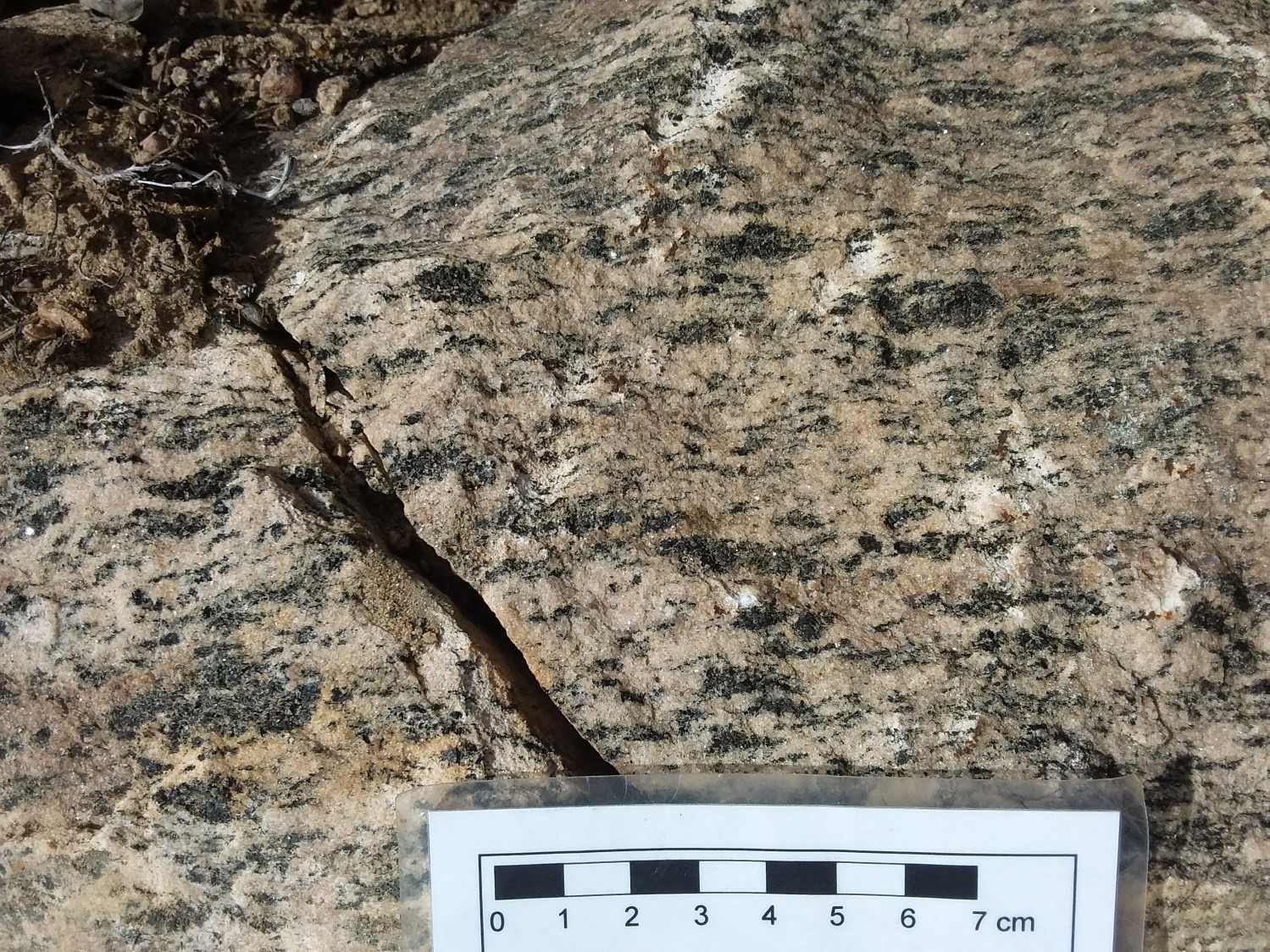 Mangerite is generally brownish-white to pink on the altered surface and greenish on the fresh surface. It is medium grained, porphyroid to locally porphyroclastic with phenocrysts of feldspar (e.g., outcrop 2021-GS-2057). Phenocrysts of potassium feldspar and plagioclase are hosted in a medium to coarse-grained matrix of quartz, biotite, orthopyroxene, green hornblende and magnetite. Allanite and epidote are accessory minerals. The proportion of feldspar phenocrysts varies from 10 to 15% of the rock, with an average length between 1 cm and 3.5 cm. Phenocrysts of potassium feldspar are perthitic and orthopyroxene is found among clusters of ferromagnesian minerals.
Mangerite is generally brownish-white to pink on the altered surface and greenish on the fresh surface. It is medium grained, porphyroid to locally porphyroclastic with phenocrysts of feldspar (e.g., outcrop 2021-GS-2057). Phenocrysts of potassium feldspar and plagioclase are hosted in a medium to coarse-grained matrix of quartz, biotite, orthopyroxene, green hornblende and magnetite. Allanite and epidote are accessory minerals. The proportion of feldspar phenocrysts varies from 10 to 15% of the rock, with an average length between 1 cm and 3.5 cm. Phenocrysts of potassium feldspar are perthitic and orthopyroxene is found among clusters of ferromagnesian minerals.
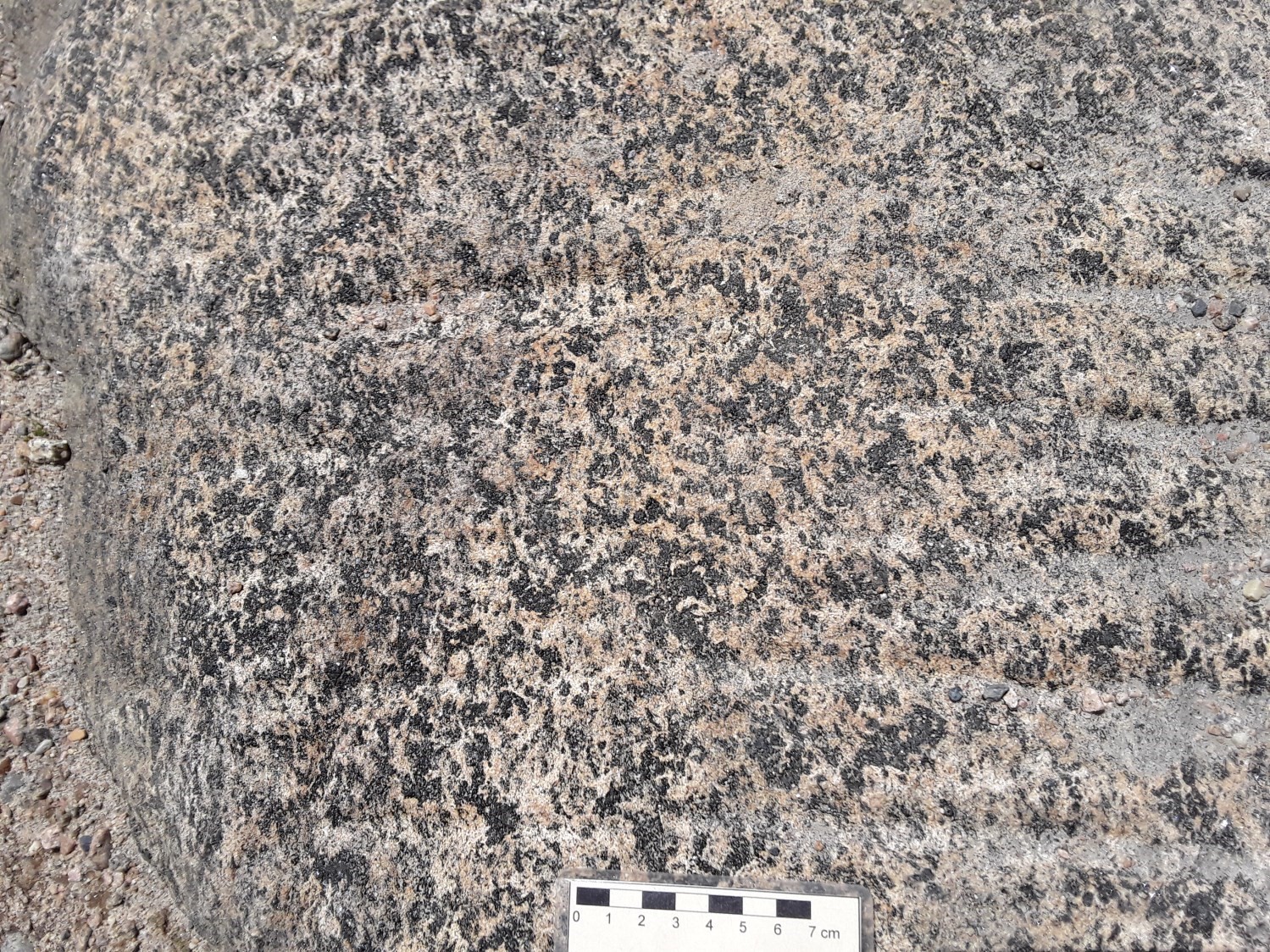 The gabbronorite is grey-green to rust-black in alteration patina and fresh surface (e.g., outcrop 2021-FT-3133). The rock is foliated, subophitic to ophitic in structure, locally coronitic and medium to coarse grained. It contains plagioclase, orthopyroxene, clinopyroxene, green hornblende, biotite, apatite and opaque minerals (magnetite). The coronitic structure consists of a core of orthopyroxene and a rim of green hornblende. In places, the gabbronorite is cut by dykes and veins of granitic composition measuring 2 cm to 1 m in thickness.
The gabbronorite is grey-green to rust-black in alteration patina and fresh surface (e.g., outcrop 2021-FT-3133). The rock is foliated, subophitic to ophitic in structure, locally coronitic and medium to coarse grained. It contains plagioclase, orthopyroxene, clinopyroxene, green hornblende, biotite, apatite and opaque minerals (magnetite). The coronitic structure consists of a core of orthopyroxene and a rim of green hornblende. In places, the gabbronorite is cut by dykes and veins of granitic composition measuring 2 cm to 1 m in thickness.
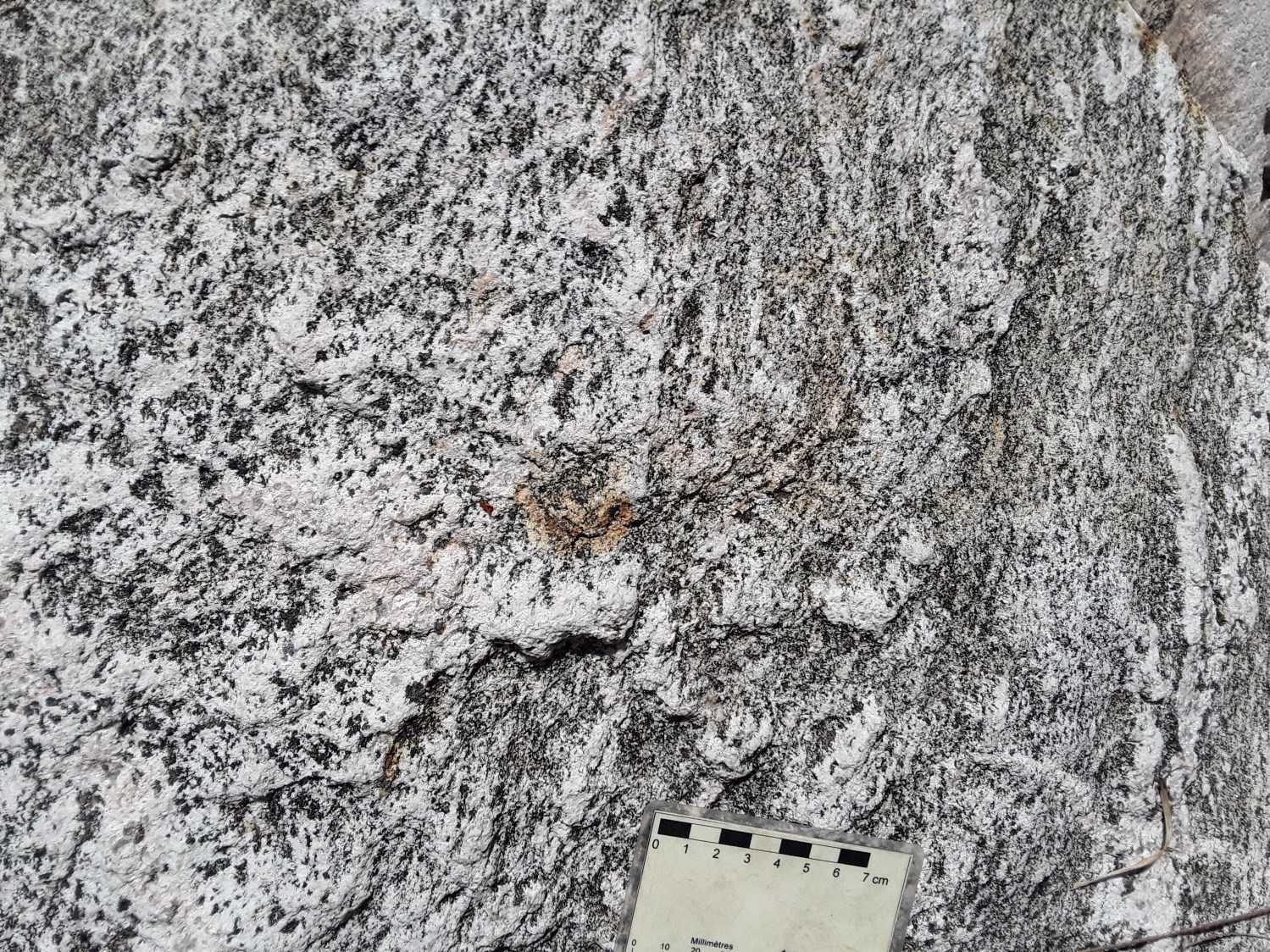 Quartz monzodiorite is grey-white in alteration patina and fresh surface, fine to medium grained, granoblastic, locally gneissic and highly deformed in the solid state (e.g., outcrop 2021-FT-3046). It is composed of quartz, potassium feldspar, plagioclase, biotite, magnetite, clinopyroxene and hornblende. Locally, the monzodiorite is mylonitic (upright gneiss). In this case, it contains pyrite, chalcopyrite as well as garnet and is emplaced along a fault of undetermined movement (e.g., outcrop 2021-FT-3142).
Quartz monzodiorite is grey-white in alteration patina and fresh surface, fine to medium grained, granoblastic, locally gneissic and highly deformed in the solid state (e.g., outcrop 2021-FT-3046). It is composed of quartz, potassium feldspar, plagioclase, biotite, magnetite, clinopyroxene and hornblende. Locally, the monzodiorite is mylonitic (upright gneiss). In this case, it contains pyrite, chalcopyrite as well as garnet and is emplaced along a fault of undetermined movement (e.g., outcrop 2021-FT-3142).
 Charnockite (hypersthene granite) is grey-white to green-brown in alteration patina, grey-brown on the fresh surface, fine to medium grained and foliated (e.g., outcrops 2021-FT-3145 and 2021-FT-3117). It consists of quartz, potassium feldspar, orthopyroxene, clinopyroxene and biotite. Locally, the charnockite is mylonitic, with grains of quartz stretched like rice grains. It is cut by pegmatite dykes (1 cm to 3 dm thick) and by fine-grained veins of ultramafic composition (5 mm to 5 cm thick) consisting of greenish clinopyroxene and arfvedsonite crystals. The charnockite also contains medium to coarse-grained boudins of gabbronorite measuring 5 mm to 5 cm in thickness. The charnockite is observed in places in the intrusion as injections that are pink on the altered surface, brown on the fresh surface, fine grained and containing orthopyroxene, magnetite and biotite.
Charnockite (hypersthene granite) is grey-white to green-brown in alteration patina, grey-brown on the fresh surface, fine to medium grained and foliated (e.g., outcrops 2021-FT-3145 and 2021-FT-3117). It consists of quartz, potassium feldspar, orthopyroxene, clinopyroxene and biotite. Locally, the charnockite is mylonitic, with grains of quartz stretched like rice grains. It is cut by pegmatite dykes (1 cm to 3 dm thick) and by fine-grained veins of ultramafic composition (5 mm to 5 cm thick) consisting of greenish clinopyroxene and arfvedsonite crystals. The charnockite also contains medium to coarse-grained boudins of gabbronorite measuring 5 mm to 5 cm in thickness. The charnockite is observed in places in the intrusion as injections that are pink on the altered surface, brown on the fresh surface, fine grained and containing orthopyroxene, magnetite and biotite.
 The quartz syenite is rust-white in alteration patina and pink on the fresh surface (e.g., outcrop 2021-FS-4068). The rock is medium to coarse grained and foliated. It consists of quartz, potassium feldspar, plagioclase, amphibole, biotite and magnetite. Under the microscope, the proportion of orthopyroxene varies from 1% to 2%. Orthopyroxene is associated with biotite, magnetite and green hornblende, all concentrated in millimetric clusters. The quartz shows a slight undulatory extinction, while the potassium feldspar is twinned in a Scottish kilt shape typical of microcline and is perthitic in places. Plagioclase is locally sericitized and accessory minerals are zircon, allanite and apatite. A syenite, pink-white on the altered surface and grey on the fresh surface, is also mapped in this suite (e.g., outcrop 2021-FT-3002). It is medium to coarse grained, locally porphyroclastic, heterogeneous and foliated. Under the microscope, it contains porphyroblasts of perthitic potassium feldspar and fractured, sericitized plagioclase. Other minerals include orthopyroxene, biotite and accessory minerals (apatite and allanite). Some outcrops of this syenite are in diffuse contact with the fine-grained gabbronorite of this suite.
The quartz syenite is rust-white in alteration patina and pink on the fresh surface (e.g., outcrop 2021-FS-4068). The rock is medium to coarse grained and foliated. It consists of quartz, potassium feldspar, plagioclase, amphibole, biotite and magnetite. Under the microscope, the proportion of orthopyroxene varies from 1% to 2%. Orthopyroxene is associated with biotite, magnetite and green hornblende, all concentrated in millimetric clusters. The quartz shows a slight undulatory extinction, while the potassium feldspar is twinned in a Scottish kilt shape typical of microcline and is perthitic in places. Plagioclase is locally sericitized and accessory minerals are zircon, allanite and apatite. A syenite, pink-white on the altered surface and grey on the fresh surface, is also mapped in this suite (e.g., outcrop 2021-FT-3002). It is medium to coarse grained, locally porphyroclastic, heterogeneous and foliated. Under the microscope, it contains porphyroblasts of perthitic potassium feldspar and fractured, sericitized plagioclase. Other minerals include orthopyroxene, biotite and accessory minerals (apatite and allanite). Some outcrops of this syenite are in diffuse contact with the fine-grained gabbronorite of this suite.
 The hypersthene syenite is pink-white in alteration patina and pink on the fresh surface (e.g., outcrop 2021-FS-4070). The rock is medium grained and foliated. In the field, the orthopyroxene content varies from 8 to 10% and is associated with biotite, magnetite and hornblende. Microscopic examination reveals the following minerals: quartz in small grains between other minerals and with undulatory extinction, mostly perthitic potassium feldspar, plagioclase and green hornblende. Accessory minerals include zircon, allanite and apatite.
The hypersthene syenite is pink-white in alteration patina and pink on the fresh surface (e.g., outcrop 2021-FS-4070). The rock is medium grained and foliated. In the field, the orthopyroxene content varies from 8 to 10% and is associated with biotite, magnetite and hornblende. Microscopic examination reveals the following minerals: quartz in small grains between other minerals and with undulatory extinction, mostly perthitic potassium feldspar, plagioclase and green hornblende. Accessory minerals include zircon, allanite and apatite.
Thickness and distribution
The Festins Plutonic Suite consists of a polyphase intrusion mapped in the western part of sheet 32H07. Interpretation of aeromagnetic maps extends it westwards (sheet 32H06), giving it a significant surface area of ~300 km².
Dating
None.
Stratigraphic Relationship(s)
The Festins Plutonic Suite is cut by the Vertu Plutonic Suite and contains kilometre-long enclaves and klippes of paragneiss and migmatite from the Barrois Complex (mPboi4).
Paleontology
Does not apply.
References
Publications available through SIGÉOM Examine
El BOURKI, M., MOUKHSIL, A. 2021. Géologie de la région de Dolbeau-Blondelas, Province de Grenville, région du Saguenay–Lac-Saint-Jean, Québec, Canada. MERN; BG 2022-02, 1 plan.
INTISSAR, R., BENAHMED, S. 2015. LEVÉ MAGNÉTIQUE AÉROPORTÉ DANS LE SECTEUR OUEST DU LAC-ST-JEAN, PROVINCE DE GRENVILLE. MERN, GOLDAK AIRBORNE SURVEYS. DP 2015-06, 7 pages and 2 plans.
Suggested Citation
Ministère de l’Énergie et des Ressources naturelles (MERN). Festins Plutonic Suite. Quebec Stratigraphic Lexicon. https://gq.mines.gouv.qc.ca/lexique-stratigraphique/province-de-grenville/suite-plutonique-des-festins_en [accessed on Day Month Year].
Contributors
|
First publication |
Abdelali Moukhsil, P.Geo., Ph.D. abdelali.moukhsil@mern.gouv.qc.ca; Mhamed El Bourki, GIT, M.Sc.A. mhamed.elbourki@mern.gouv.qc.ca (redaction) Mehdi A. Guemache, P.Geo., Ph.D. (coordination); Fabien Solgadi, P.Geo., Ph.D. (critical review); Simon Auclair, P.Geo., M.Sc. (editing); Catherine Tremblay (English version). |

